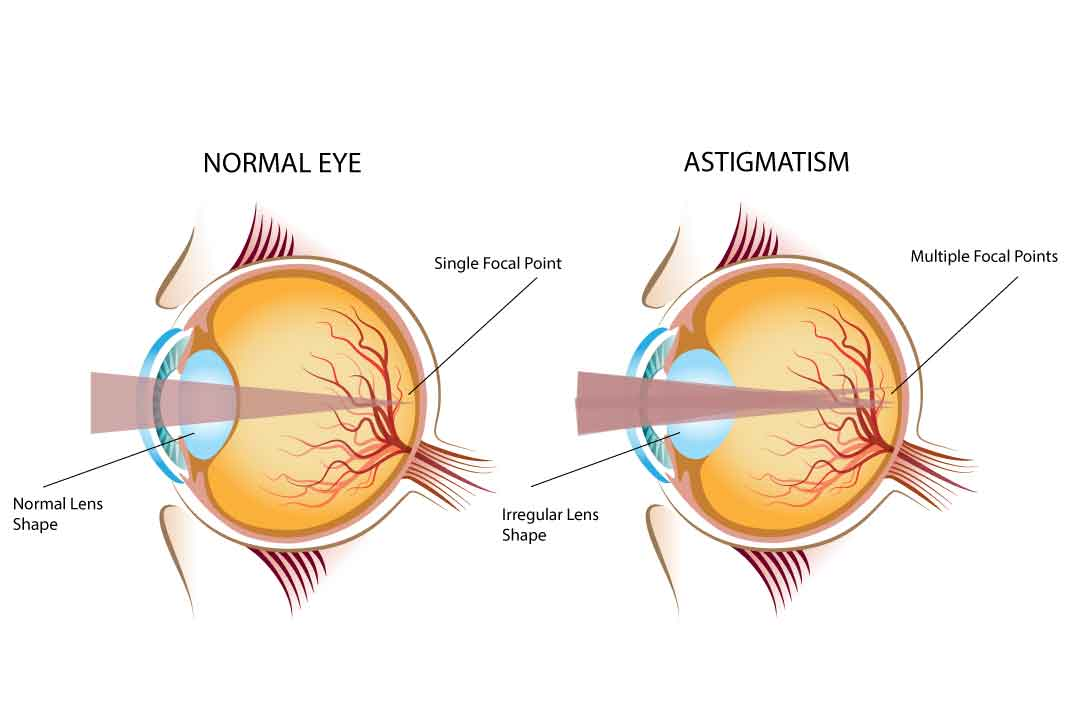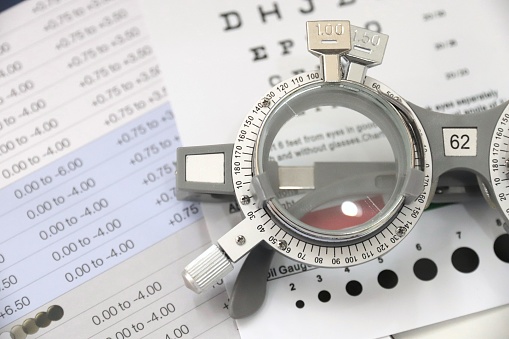Are your vision problems causing you to feel frustrated and confused? You may have astigmatism! Astigmatism is a common eye condition leading to blurred and distorted vision. It occurs when the cornea, the front part of the eye, becomes abnormally curved or shaped. This causes light rays entering the eye to be deflected at different angles, resulting in impaired focusing abilities and visual distortion.
Fortunately, many treatment options are available for astigmatism to achieve clearer and more focused eyesight. Please keep reading to learn more about what causes astigmatism and how it's treated!
What is astigmatism?

Astigmatism is a refractive eye error that causes blurred vision at any distance. Astigmatism occurs when the shape of the cornea, or the clear outer layer of the eye, is not perfectly round, like a football instead of a basketball.
This irregularly shaped surface causes light to be focused on multiple points in front of and behind the retina instead of all at a single point. This leads to blurred vision, as well as light sensitivity and headaches. Astigmatism is usually hereditary but can also be caused by an injury to the eye or other eye conditions.
Fortunately, astigmatism can easily be corrected with eyeglasses and contact lenses that provide focused vision throughout the entire field of view. In some cases, surgery may be needed to correct astigmatism.
What are the symptoms of astigmatism?
Astigmatism can cause blurred vision at all distances, including near and far. You may also experience eyestrain, headaches, and fatigue from squinting or straining to see clearly. Other symptoms may include:
- Difficulty with night vision
- Glare and halos around bright lights
- Eye discomfort or irritation
- Double vision in one eye
- Squinting to see clearly.
It's important to have your eyes examined regularly. If you suspect you have astigmatism, schedule an appointment with your eye care professional immediately. They can determine if the symptoms are due to astigmatism and provide you with a prescription to help correct it.
Corrective lenses, such as glasses or contact lenses, can help improve your vision and reduce many of the symptoms associated with astigmatism. Your eye care professional may also recommend other treatments, such as orthokeratology or refractive surgery.
Whatever treatment options you choose, it's important to follow through with regular check-ups with your eye doctor to monitor any changes in your vision.
What causes astigmatism?

An irregularly-shaped cornea usually causes astigmatism. The cornea is the transparent outer layer of the eye that helps to focus light into the eye so that images will be seen clearly. When this layer has an irregular shape, it causes distorted vision because light rays are not evenly refracted (bent).
An irregular lens curvature inside the eye can also cause astigmatism. In some cases, astigmatism is present at birth; in others, it may develop later due to a change in the shape of the cornea or lens. Astigmatism can also be caused by injury or certain surgeries that affect the shape of the eye.
The most common symptom of astigmatism is blurred vision at all distances. Other symptoms may include eyestrain, headaches, squinting, or headaches after prolonged reading. People with astigmatism may also have difficulty seeing well at night and experience glare from lights.
If you notice any of these symptoms, it's important to see your eye doctor for a comprehensive eye exam to determine if you have astigmatism. The right corrective lenses can help reduce or eliminate symptoms of astigmatism.
If you have astigmatism, don't worry - it is a common condition that can be easily corrected with corrective eyewear. Speak to your eye doctor to learn more about treatment options for astigmatism.
Astigmatism Diagnosis and Treatment
When visiting the eye doctor, several tests can be used to diagnose astigmatism. These include a refractive error test (to measure how well you see at different distances), corneal curvature measurement, topographic analysis of the cornea, and retinoscopy.
Once astigmatism is diagnosed, there are several treatments available, depending on the severity. These include eyeglasses or contact lenses with different meridian powers to correct vision. Refractive surgery is another option for more severe cases of astigmatism.
This involves reshaping the cornea to reduce refractive errors and improve vision quality. Vision therapy is also available as a non-surgical option involving specific exercises to help the eyes focus more accurately.
No matter which treatment for astigmatism is chosen, regular visits to the eye doctor are important for monitoring and managing your condition.
How will my eye doctor check for astigmatism?
Your doctor will use a series of tests to determine if you have astigmatism. The first is called refraction, which measures your ability to focus on the retina. Your doctor may also use a retinoscope and other devices to measure how your eye focuses light rays on the back of the eye.
You may also be asked to look into a series of lenses to determine which lens gives you the clearest vision. Additionally, your eye doctor may use an optical coherence tomography (OCT) scan to measure the cornea's curvature. This test can provide detailed measurements of any abnormalities in shape and curvature, indicating astigmatism.
Once astigmatism has been diagnosed, your doctor will determine whether glasses or contact lenses are the best way to correct your vision. Sometimes, a combination of contact lenses and glasses may be necessary. Additionally, your doctor may recommend special vision training exercises to help strengthen the eye muscles and improve your vision.
FAQs
What does astigmatism do to your eye?
Astigmatism is an imperfection in the curvature of the front surface of your eye (the cornea), which causes blurred vision. It occurs when light rays entering the eye are not focused properly onto the retina at the back of the eye.
This can result in distorted vision for near and far objects or only one type of distance. An oddly shaped cornea or lens can cause astigmatism and may sometimes worsen with age.
Several possible treatments for astigmatism include eyeglasses, contact lenses, refractive surgery, and other vision correction procedures. The right treatment can often help you achieve clear vision without discomfort.
Is astigmatism good or bad?
Astigmatism is a vision condition that can cause blurred vision. It is not necessarily "good" or "bad," but getting an accurate diagnosis and appropriate treatment is important if you think you may have astigmatism.
With the right treatment, many people with astigmatism can achieve good, clear vision without discomfort. If left untreated, astigmatism can worsen over time, potentially leading to more serious vision problems. Everyone should have regular eye exams to ensure their eyes are healthy and any vision conditions are identified and treated early.
What is the best treatment for astigmatism?
The best treatment for astigmatism depends on the severity of the condition and individual preferences. Common treatments include eyeglasses, contact lenses, refractive surgery, and other vision correction procedures. Your eye doctor can discuss your options and suggest the best treatment. The right treatment can often help you achieve clear vision without discomfort.
Conclusion
In Conclusion, astigmatism is a refractive eye error caused by an irregularly shaped cornea. Symptoms include blurry vision at all distances, headaches, squinting, and eye strain. Commonly, astigmatism can be corrected with eyeglasses or contact lenses. Surgery may also be recommended to correct extreme cases of astigmatism.
If you are experiencing any of the symptoms mentioned, it is advised to consult an ophthalmologist for an accurate diagnosis and treatment that best fits your lifestyle. Astigmatism can be managed over time by taking corrective measures and understanding the condition to maintain optimal vision.




